
Recipients of the Region X Commitment to Safety Award:
2024: Troy Swanberg, Engineers Great Lakes Region (EGL)

Article by Shannon Lyman (Boston Center, ZBW)
NATCA congratulates the 2024 recipient of the Region X Commitment to Safety Award, Troy Swanberg (Engineer/Great Lakes Region, EGL). The Region X Commitment to Safety Award is given annually to a Region X member who has shown a profound dedication to ensuring the safety of the National Airspace System (NAS). The award is peer-nominated, and any Region X member in good standing can be nominated for work done in their role as an aviation safety professional. Troy is a Mechanical Engineer with the FAA and has worked to keep the NAS safe for the last 33 years.
Troy was a charter member of NATCA when the engineers first petitioned to be represented by NATCA in 1997. He has been involved with NATCA in various leadership roles within the Union and is currently serving as the EGL Region X Representative. About 8 years ago, NATCA presented Troy a role to participate in safety-related activities, and he’s grown and flourished in that role over the years.
During project implementations in 2017, unscheduled outages at New York TRACON (N90), Washington Center (ZDC), and other FAA facilities caused major issues within the NAS. Following these incidents, Troy led a collaborative workgroup tasked with creating and delivering training to Engineering Services which resulted in the Project Implementer Operational Risk Management (ORM) workshop. In 2019, he facilitated this training to more than 1,000 employees which resulted in a reduction in unscheduled outages during project implementations in the forthcoming years.
Troy was also the lead NATCA member on the collaborative effort to create the Project Strategic/Tactical ORM (STORM) workshop. During the creation of the workshop, Troy ensured the training was an in-person offering and provided the greatest value to the workforce by championing its format, which brings personnel from the three primary parties involved in the implementation of projects in the NAS: Technical Operations, Engineering Services, and Air Traffic. He has facilitated most of the 160 Project STORM workshops to date which has provided more than 4,200 FAA employees and contractor personnel with the understanding of how to perform ORM during projects in the NAS.
Troy’s colleague Jon Stanton (Engineer/New England Region, ENE), who nominated Troy for this award, said, “As a member of the 6000.15 General Maintenance Handbook and 6000.50 NAS Project Implementation Risk Management revision teams, Troy was instrumental in policy updates that ensured improvements to the operational impact of projects on the NAS.”
Al Arcese (ENE) highlighted Troy’s support of the Air Traffic Safety Action Program (ATSAP)-X program. “Troy is a very vocal supporter of all of our voluntary safety reporting programs, especially ATSAP-X. His enthusiasm for ATSAP-X has always ensured that the briefings in Chicago consistently have the highest local turnout and participation.”
Reflecting on what safety means to him, Troy says, “Safety is about getting our mindset to where we always have that in the back of our mind that we want to make sure we’re considering risks, and we’re doing our best to make sure we keep the flying public as safe as we can. From an engineering perspective, we shorten it to ‘don’t surprise air traffic.’” When asked if he had advice to his colleagues looking to be more safety focused, he said, “It’s not about you just installing this cable, or it’s not about you just doing this design. It’s really the big machine that we’re part of. We all have a role in making sure that we keep the flying public safe.”
Congratulations to the 2024 Region X Commitment to Safety Award winner Troy Swanberg!
– Region X Vice President Mark Rausch
Watch the award presentation:
2023: Bruce V. Williams, Engineers Southern Region (ESO)
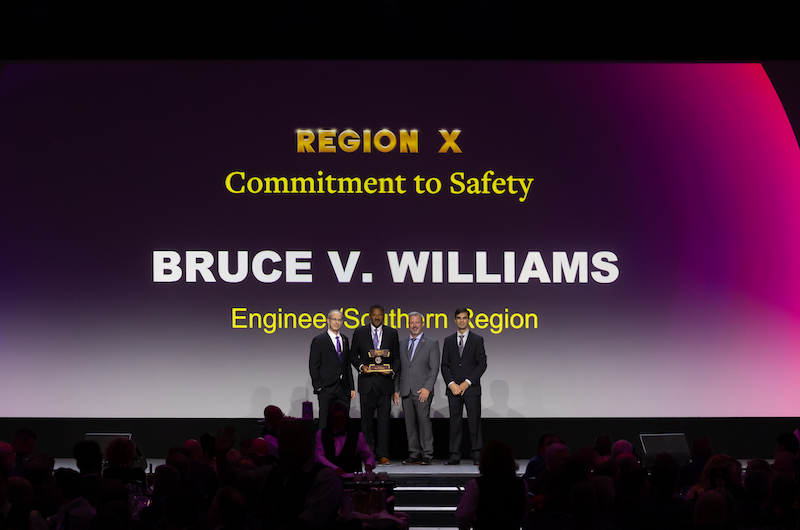
Article by Lisen Minetti, Engineer/Aeronautical Center (EAC)
NATCA congratulates the 2023 recipient of the Region X Commitment to Safety Award, Bruce V. Williams (Engineer/Southern Region, ESO). The Region X Commitment to Safety Award is given annually to a Region X member who has shown a profound dedication to ensuring the safety of the National Airspace System (NAS). The award is peer-nominated, and any Region X member in good standing can be nominated for work done in their role as an aviation safety professional. Bruce began his career with the FAA in 1995 in Tech Ops working in the Spectrum Engineering Group mitigating radio frequency interference.
Bruce joined NATCA in 2001 and has been involved in several national technical challenges, including frequency divesture and the recent 5G mobile telephone system launch. To get radio interference problems solved quicker, his team developed a real time frequency analysis platform to identify radio interference to crucial NAS communications. Over the course of Bruce’s career, he has seen interference from radio frequencies from CB radios, terminal doppler radios, and commercial radio stations, just to name a few.
The investigation and mitigation of identifying these issues range from a simple fix to very complex investigations that may take months, or even years, to resolve. Using information received from reports given by air traffic controllers, Bruce uses a variety of methods to determine the source of the problem. Sometimes that information comes from the time of day or type of interference reported. For example, if the interference is coming from a local radio station, knowing the genre of music goes a long way towards helping to identify the source.
This is important work, because any time a pilot or controller is unable to communicate with one another or when there is a degradation of signal within the NAS due to radio frequency interference, the ability of air traffic controllers to perform their jobs is compromised.
However, Bruce’ job does not only deal with investigating unintentional interference. He also investigates incidents of intentional interference aimed at disrupting the NAS. Early in his career, Bruce participated in a two-years long joint investigation between the FAA, the Federal Communications Commission (FCC) and the Federal Bureau of Investigations (FBI) to identify the source of frequency jamming impacting Atlanta Center and the ATL Tower. Bruce provided the FBI with the information needed to serve a warrant on the perpetrator’s home and even participated in the search and seizure of the jamming equipment that was used to disrupt the radio frequencies. The perpetrator was arrested, tried and convicted of knowingly and intentionally disrupting air traffic control signals and served two years in prison.
In the past two years alone, Bruce has investigated and resolved several instances of radio frequency interference impacting the Indianapolis Center (ZID), Regional Southwest Ft. Myers International Airport (RSW), Miami Center (ZMA), Atlantia Center (ZTL), Wilmington International Airport (ILM), and Miami ATCT (MIA). Always humble, Bruce is quick to share credit with his brothers and sisters in air traffic control: “In almost every case, much of my success is attributed to controllers who have been very, very diligent in providing data…It is the controller’s information that is the key to us resolving these issues. And when they give us good information, it makes all the difference in the world.”
“Bruce has spent his 35-year career resolving spectrum interference problems affecting critical communication, navigation, and surveillance systems necessary for safe and efficient operation of the NAS,” said NATCA EAC President Don Smith, who nominated Bruce for the award. “Bruce’s engineering expertise, experience, and tenacity have had a direct impact on the safety of the NAS.”
“Bruce’s dedication is not only on full display when there is a high visibility issue he is addressing but what makes Bruce special is what he does when nobody is looking – a consummate professional ensuring the safety of the flying public,” added Region X Vice President Brad Davidson. “We could not be prouder of Bruce as a region and as a union for this well-deserved recognition.”
“I think it’s a real honor to be recognized by air traffic controllers,” commented Bruce. “Because ultimately, those are the people you’re really working for – the controller and the pilot. For air traffic controllers to recognize that you’ve been doing a great job over the years is very satisfying.”
Congratulations to the 2023 Region X Commitment to Safety Award winner Bruce V. Williams!
– Region X Vice President Brad Davidson
Watch the award presentation:
2022: Jon Stanton, Engineers New England (ENE)
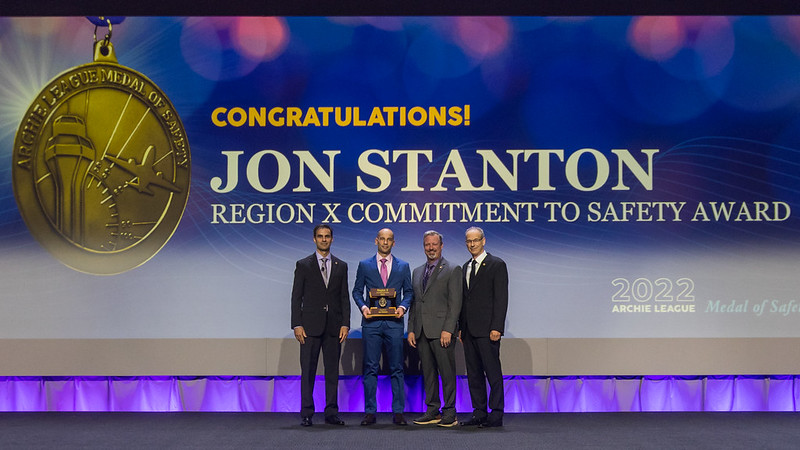
Article by Lisen Minetti (Engineer/Aeronautical Center, EAC)
NATCA congratulates the 2022 recipient of the Region X Commitment to Safety Award, Jon Stanton (Engineers New England, ENE). The Region X Commitment to Safety Award is given annually to a Region X member who has shown a profound dedication to ensuring the safety of the National Airspace System (NAS). The award is peer-nominated, and any Region X member in good standing can be nominated for work done in their role as an aviation safety professional. Stanton’s career in Engineering Services with the FAA spans nearly twenty years, and he has been an active member of NATCA for just as long.
For the past two years, Stanton has focused on operational risk management policy and training, where he has utilized his vast experience working in the field to create policy and training programs geared towards identifying and mitigating risk related to engineering service tasks that may impact the functionality of the NAS and compromise the ability of air traffic controls to perform their jobs.
“Operational risk management is a critical component for engineer safety and involvement in the NAS,” said Troy Swanberg, Engineering Service, systems engineer (Great Lakes Regional Office) who nominated Stanton. “Jon has been a leader in sharing this message and is one of the most dedicated people I know in making sure the work we do comes out in a professional way, sharing information in an open and honest tone with the engineering workforce.”
From power outages to radio delays to radar problems, it goes without saying that any outage in the NAS – even those that are planned – has a major impact. Stanton’s work focuses on identifying when these risks will occur, the trends associated with these outages, and collaboration between Engineering Services, Tech OPS, and Air Traffic Control to ensure that everyone has the tools needed to move forward with minimal disturbance to normal functions.
“I feel fortunate that I am on this path, quite unexpectedly. I was able to transition from a more hands-on role working on projects with a safety component to working operationally and with employee safety. Now that I am looking at policy, promoting operational risk management, and working on training, I feel like I can contribute in a different way. I can take the experience that I’ve built up over all these years, working on projects, and learning a lot, and take that knowledge and pay it forward to the good people that we have in engineering services,” Stanton said.
While the Archie League Medal of Safety Awards demonstrate the amazing saves of our Air Traffic Control brothers and sisters, Region X’s Commitment of Safety Award demonstrates that all members of NATCA are dedicated to the safety and well-being of the flying public and the NAS.
“We have great people working in Region X that come to work every day and are contributing in their own way to the mission and I’m thrilled every day that I get to come in and work this great job,” commented Stanton. “I’m really fortunate that I have people around me that share that same passion around our mission of having the safest and most efficient national airspace system.”
“Jon Stanton is a true professional and a major asset to both the FAA and NATCA,” added Region X Vice President Brad Davidson. “As an experienced Electronics Engineer for many years he has taken on a myriad of complicated projects and handled them all successfully. The raising of the ASR-9 in Providence Rhode Island and the relocation of the CAPE TRACON to A90 in Merrimack, NH are just 2 of the high-profile, high-risk projects Jon orchestrated successfully. By working closely with Air Traffic, his counterparts in NATCA and Tech OPS Jon turned them into low-risk projects. His understanding of the Air Traffic world, his relationship with the facility reps, and his ability to collaborate have been critical to his success. Jon is the guy you want on your workgroup and has stepped up to represent his brothers and sisters on many efforts, too many to name. The kid that showed up in New England and quickly was tagged “newbie” is one of our best now. (Sorry Jon it wasn’t our fault, you carried that too long. They didn’t hire forever!).”
– Region X Vice President Brad Davidson
Watch the award presentation:
2021: Barry Hammer, Engineers New England (ENE); Cindy Hirsch, Engineers Northwest Mountain (ENM); and Terry Washington, Engineers Southern Region (ESO)
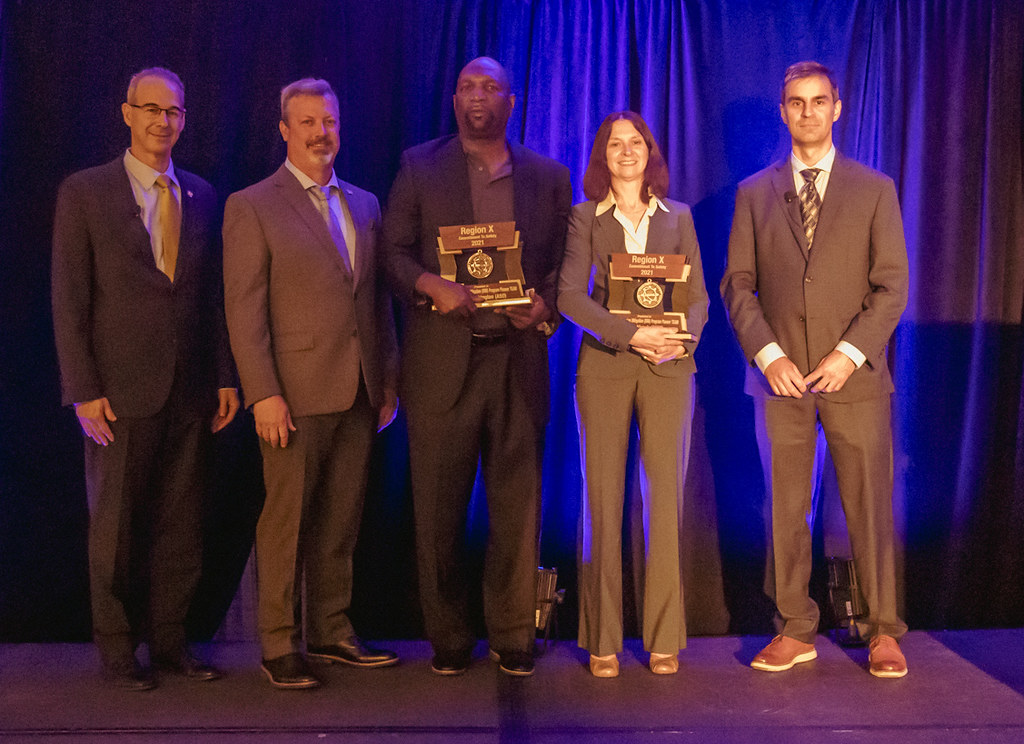
The 2021 recipients of the Region X Commitment to Safety Award are Barry Hammer (Engineers New England, ENE, pictured far left), Cindy Hirsch (Engineers/Northwest Mountain, ENM), and Terry Washington (Engineers Southern Region, ESO, pictured center). They are the NATCA members who are the leads for their respective FAA regions for the Runway Incursion Mitigation (RIM) safety-related program from the FAA Office of Airports (ARP). They are managing the RIM program on behalf of their regions, working in concert with regional and national FAA staff to execute it.
Reducing runway incursions at the over 500 towered airports in the National Airspace System (NAS) is a top priority for the FAA. Runway incursions occur when an aircraft, vehicle, or person enters the protected area of an airport designated for aircraft landings and takeoffs. The FAA Office of Airports (ARP) initiated the RIM program in fiscal year (FY) 2015 to improve safety at locations with history of incursions based upon research that showed a relationship between certain runway, taxiway, and apron configurations and the likelihood of runway incursions. The result is a risk-based, data-driven program that works to reduce runway incursions by helping airport sponsors identify and address risks at specific on-airport locations that have a history of runway incursions.
In FY 2012, ARP initiated a research study to examine the relationship between taxiway layout and safety risk. This effort involved developing a Geographic Information System (GIS) database with these problematic taxiway geometry (PTG) locations, pilot deviation and vehicle/pedestrian deviation runway incursions (including wrong runway events and surface incidents), and hot spots all shown graphically on an image of the airport layout. As a result, the RIM program was launched in FY 2015 in an effort to mitigate the non-standard geometry factors present at these locations, with the intention to reduce the number of runway incursions.
Examples of problematic taxiway layouts include direct taxiing access from ramps to the runway and wide expanses of taxi pavements along the runway.
To be designated a RIM location, the area either experienced three or more runway incursions in a single calendar year (CY), or its cumulative incursion counts averaged one or more incursion(s) per year of data analyzed. The incursion data is examined annually. Since the 2019 database update, cumulative incursion analyses are limited to the previous 10 CYs of available RI data.
According to the “RIM Program Mitigation Analysis Fiscal Year 2021” report, at the end of FY 2021, there were 129 RIM locations in various stages of mitigation. Mitigation strategies include changes or enhancements to signage, markings, or lighting; closures of runways or taxiways; new construction; changes to airfield operational procedures; and outreach and education to airport users to enhance situational awareness. The lead times for mitigations can be very long, as many of the locations are examined in the context of an overall master plan for the airport.
According to the same report, as of September 2021, the RIM program mitigated 74 runway/taxiway locations since its inception.
Airport Sponsors work with FAA Airports Division staff members, other FAA lines of business, and industry to plan and implement projects. Projects may be funded all or in part by programs executed by the FAA Office of Airports including Airport Improvement Program (AIP) grants, other Federal grants such as those resulting from the Bipartisan Infrastructure Law, and Passenger Facilities Charges (PFCs).
Airports Division RIM Program leads in each region work to educate the various parties on the types of problematic layouts, help to review and validate the concerns at each location, encourage that progress be made with mitigations, and assist with mitigation solutions.
The post-mitigation runway incursion rates are formally tracked, analyzed, and reported out on an annual basis following project completion. This analysis allows the team to identify successful outcomes or know when more work needs to be done.
Watch the award presentation:
2020: Al Arcese, Engineers New England Region (ENE)
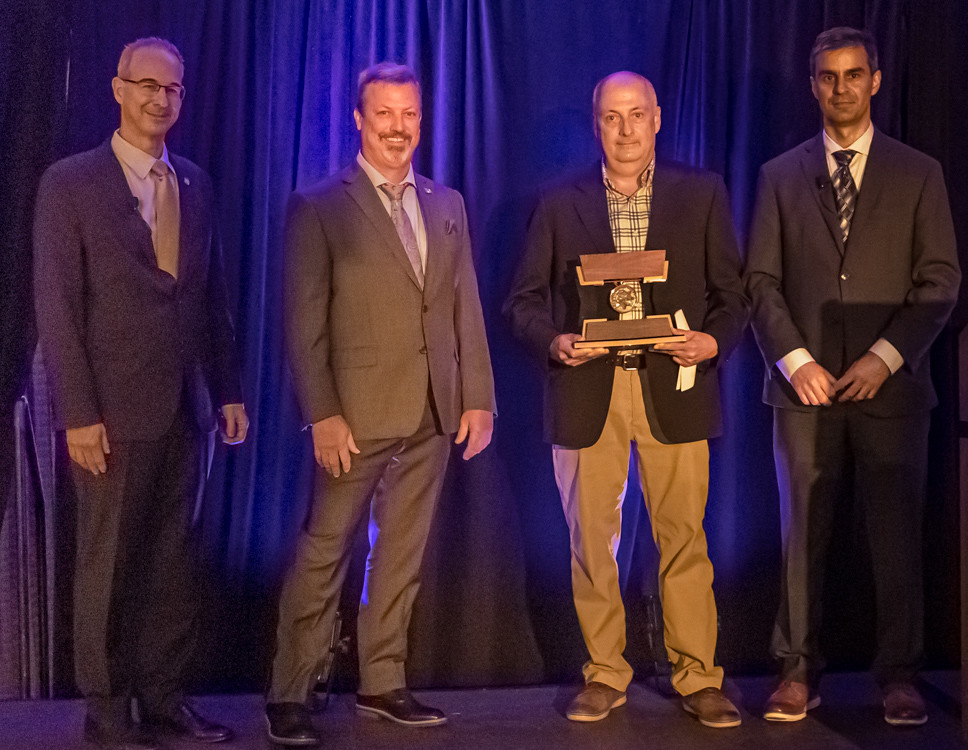
The Region X Commitment to Safety Award is given annually to a Region X member who has shown a profound dedication to ensuring the safety of the National Airspace System (NAS). The award is peer-nominated, and any Region X member in good standing can be nominated for work done in their role as an aviation safety professional.
NATCA congratulates the 2020 recipient: Engineer/New England Region (ENE) member Al Arcese. He is a Civil Engineer/Project Execution Lead in the Boston Navigation & Landing Aids Engineering group and is the NATCA Air Traffic Safety Action Program (ATSAP)-X Event Review Committee (ERC) representative. Arcese’s Federal Aviation Administration (FAA) career spans more than 31 years, and he became a member of NATCA immediately upon being eligible to join in 1997, when the Union proudly welcomed the Engineers and Architects bargaining unit into the NATCA family.
“Al Arcese is a true professional that is the face of the ATSAP-X program” said ENE member and Alternate Regional Vice President Bob Aitken, who nominated Arcese. “His dedication as an experienced NavAids Engineer, a commercial rated pilot, and flight instructor comes through every day. I can’t think of anyone more deserving of this award.”
“It is rare to find the complete package of a true aviation safety professional,” added Region X Vice President Brad Davidson. “Al is extremely knowledgeable, hard working, dedicated, an excellent communicator, and brings a wide variety of personal and professional experience to the benefit of both the FAA and NATCA. Al’s role as our lead for the ATSAP-X program is just a demonstration of his commitment to safety.”

“I am incredibly humbled and surprised to receive this award,” said Arcese. “I am grateful to NATCA for all the hard work done for its members and for aviation safety. I have always felt very strongly about organized labor and was thrilled when we were allowed to join. I have actually been both a member of NATCA and ALPA concurrently.
“As a former airline pilot, and currently an active charter, Chief Pilot and Flight Instructor, aviation safety has always been incredibly important to me. I was honored when I was asked to play a part in initiating the Voluntary Safety Reporting Program for Region X. I commend NATCA for recognizing the hard work and safety contributions that our Region X members make to the NAS, and for giving them a voice and a process for elevating their safety concerns. I thank all of the other ERCs and all of NATCA’s many safety programs for welcoming and working with Region X and for their support. I feel very strongly about promoting a collaborative culture within the FAA, and I have seen firsthand how this positive culture benefits the flying public. I have been very lucky to have a supportive family and friends throughout my career, and thank them as well.”
Watch the award presentation:
2019: Michael Collins, Engineers Northwest Mountain (ENM)
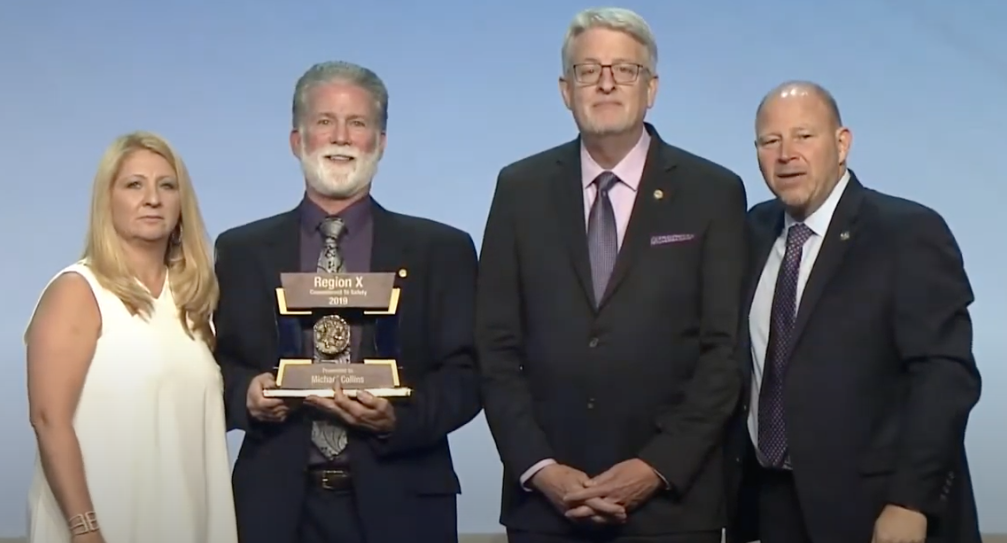
Michael Collins retired in 2018 after having served the National Airspace System (NAS), the Federal Aviation Administration (FAA), and NATCA with a deep commitment to improving safety.
Collins was a founding member of both NATCA’s Aircraft Certification (AIR) bargaining unit and the Seattle Local Engineers Northwest Mountain (ENM) safety committee. He was on the NATCA negotiating team with National Safety Committee (NSC) Chairman Steve Hansen and ENM retired member Mike McRae for the AIR voluntary safety reporting process. He also served over five years as NATCA’s Region X AIR representative on the NSC. In that capacity, he participated in monthly NASA safety team meetings, and authored and coordinated submissions on NATCA comments to aircraft Airworthiness Directives (ADs), exemptions, and proposed rulemaking.
He also drafted and coordinated comments on numerous FAA regulatory proposals, pointing out safety issues that should be addressed on transport airplanes.
AIR member Tomaso DiPaolo from the Engineers Great Lakes Region, noted that Collins was one of two founding NATCA reps on the Safety Review Process (SRP) panel that reviewed and made safety determinations on all aircraft certification SRP reports. The SRP replaced the FAA’s Safety Issues Reporting System (SIRS) for NATCA-covered AIR employees
“Dozens of safety recommendations were created by SRP and forwarded to FAA top management for implementation,” DiPaolo said. “He was instrumental in helping to improve the air safety system in AIR these past few decades.”
AIR member Della Swartz from the Region X local in Anchorage, Alaska, said Collins “advocated tirelessly for safety within the FAA, even when that conflicted with his management.”
As the AIR representative on the NSC, Swartz said Collins brought safety concerns within AIR to the attention of NATCA leadership. “He wrote white papers to explain the issues, as well as taking the lead in writing comments to FAA rulemaking on behalf of NATCA to ensure our safety concerns were heard,” she said. “Mike never forgot that safety is the reason we are here and come to work every day. His unwavering passion for safety is truly inspirational.”
AIR Rep Scott Odle noted that while Collins was on the NSC, he worked on the initial development of some of the new safety training programs that AIR employees now enjoy. This includes the Aircraft Accident Investigation Safety (AAIS) Program, and employee fall protection and hearing conservation programs for AIR employees.
Odle said Collins was also a member of the Federal Aviation Regulation (FAR) Part 21 Safety Management Systems Aviation Rulemaking Committee (SMSARC). His duties within the FAA were to ensure the safety of aircraft designs. He did that, Odle said, by ensuring that the final design was an FAA AIR Service-approved design that complied with the FARs.
Added Odle, commenting on Collins’s eight years as the lead Occupational Safety and Health Administration (OSHA) Rep for NATCA AIR: “He worked extensively in service to his fellow co-workers on the Northwest Mountain Regional Office move and the building issues associated with the move. That included such safety-related items as water and indoor air quality at the new building.”
Watch award presentation below.
2018: Irene Porter and Ernest Gubry, Engineers Great Lakes Region (EGL)
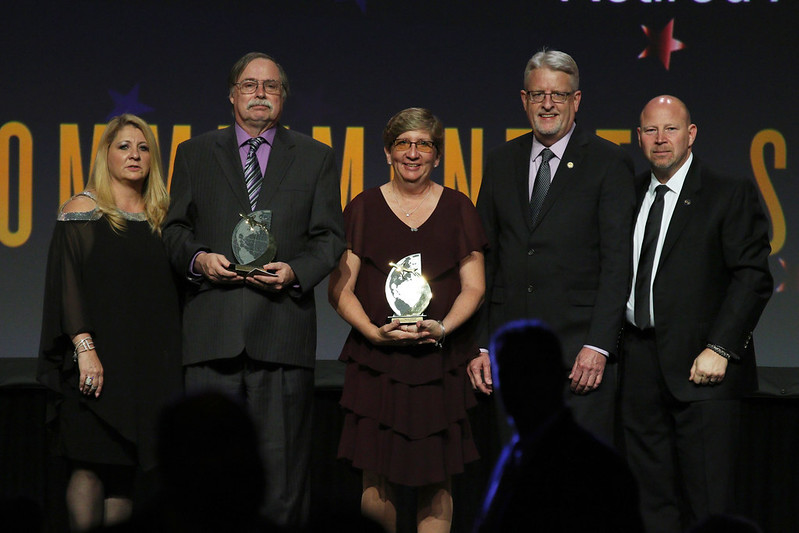
Moe Wagner was with his University of Michigan basketball teammates on March 8, 2017, aboard an Ameristar Air Cargo MD-83 as it began its takeoff roll down Runway 23 Left at Willow Run Airport in Ypsilanti, Mich. The aircraft, headed to Washington Dulles for the Big Ten tournament, reached 173 knots. However, due to a mechanical failure, the aircraft did not pitch up and the pilots executed a rejected takeoff.
Wagner wrote about what happened next, in The Players Tribune:
“I just see everyone … this plane full of my Michigan family … with this look on their faces that I don’t even recognize. It’s almost, like, an entire emotion that I’ve never seen before. I immediately turn back around. I lean over to look out the window. We’re careening off the runway and into a field.
“Oh no, I think. Oh, God. Oh no. This is actually happening. We actually might die.”
The aircraft overran the end of Runway 23 Left and stopped on grass, 1,000 feet from the end of the runway. All 109 passengers and seven crew members evacuated the aircraft and only one person suffered minor injuries during evacuation, according to the NTSB.
That Wagner, now a rookie with the Los Angeles Lakers, and the other passengers survived this incident is a direct result of the work of NATCA-represented Airports Division (ARP) members Irene Porter and Ernest Gubry. Porter, who recently retired, and Gubry initiated, designed, planned, environmentally cleared, and funded the construction of a fully compliant runway safety area (RSA) at Willow Run. They oversaw and managed the project from initial concept through construction.
For their work, Porter and Gubry were presented with NATCA’s annual Region X Commitment to Safety Award.
One of the more high profile programs in the Airports Division is the RSA improvement program. Beginning in 2000, Airports Division identified deficient RSAs at commercial service airports, which were considered the highest priority locations. Employees improved 642 deficient RSAs by the congressionally-mandated 2015 deadline at a cost of over $3 billion. Every location with a RSA deficiency involves Airports Division engineers, planners, program managers, environmental protection specialists, financial specialists, compliance staff, and certification inspectors to identify and implement solutions.
“We truly have a team effort in addressing and solving safety-related issues at the airports we oversee across the nation,” said NATCA Airports Division rep Brad Davidson, who notes that ARP is a small group of dedicated aviation safety professionals and has approximately 350 bargaining unit employees spread across the country. “We often hear about the flawed logic that, ‘we have never had an incident or crash here so why do we need to improve our RSAs to meet standards?’
“Well the University of Michigan men’s basketball team can tell you why – because the unexpected can happen at any time. The added margin of safety with the construction of fully compliant RSAs at Willow Run contributed to saving the lives of 109 passengers and seven crew members.”
Watch award presentation below.
2017: Steve Rosenfeld, Engineers Great Lakes Region (EGL)
In 2011, a small airplane directorate invited Steve Rosenfeld to take part in pre-decisional involvement on the Title 14 Code of Federal Regulations (CFR) Part 23 reorganization of the aviation rule-making committee. Rosenfeld advised the group on behalf of NATCA because of his extensive expertise and knowledge in airworthiness regulations and procedures.
For this effort, he developed official engineering safety input, questions and comments for the main body of the rule-making committee, and organized and submitted all other comments generated from NATCA Air Certification bargaining unit employees.
His efforts improved safety for general aviation (GA) aircraft by initiating a move from prescriptive to performance-based regulations, and developing an internationally recognized and standardized means of compliance. Through the rule-making decisions on these efforts, there were discussions in the industry for the next five years. Rosenfeld led efforts to develop an official NATCA response to the FAA rule-making committee by working with the National Safety Committee. He worked with NATCA to provide comments to the concurrent European rule-making effort. His efforts served as part of a broader push to harmonize the FAA with procedures abroad in certification regulation — a monumental undertaking worthy of praise.
“We thank Steve for his long-term dedication to aviation safety and for being a strong NATCA leader through these various collaborative efforts,” said Region X Regional Vice President Mike MacDonald.
The new performance-based Part 23 changes became effective Aug. 30, 2017, for use by GA industry. Rosenfeld continues to demonstrate his dedication to the safety of the NAS as NATCA lead on the American Society for Testing and Materials, the GA Aircraft Standards Committee, and on other industry civil airworthiness authorities in the FAA. Rosenfeld also serves as the NATCA Rep for the Small Airplane Directorate Part 23 training development effort to bring real-time training to NATCA Certification Safety Engineers, and helping bridge the gap between old and new certification philosophies.
Watch award presentation below.
* 2011: Mark Anderson, Engineers Central Region (ECE)
In 2011, NATCA presented an Archie League Medal of Safety Award to a Region X member for the first time. That member, Mark Anderson, was honored for performing a remarkable save of his own. This one was in the air, rather than on the ground. His story is below:
Anderson has been a test pilot for 25 years, working for the FAA for 20. So, when asked several years ago if he’d be interested in helping out with the Boeing 787 certification program, this Aircraft Certification member of Region X, of course, said yes.
So far, Anderson has acted as a 787 guest test pilot for about five or six flights, but on Nov. 9, 2010, he came across his biggest test yet.
Things started going poorly at about at 1,000 feet above the ground as Anderson came up on the end stretch of his six and a half-hour test flight. He was flying the airplane manually through the head-up display when the display suddenly went dark. Moments later, the auto-brake clicked, and the first call declaring smoke in the cabin followed. Then, with the call of fire at 500 feet, about 30 or so Engine Indicating and Crew Alerting System (EICAS) warning, caution, and advisory messages started rapidly displaying. All four engine-driven generators dropped off the line and attempts to start the auxiliary power unit failed. “At best,” Anderson recalled, “we thought we had partial electrical power, but maybe as little as an aircraft battery and the ram air turbine, which provides emergency back-up electrical power.”
Anytime you have a smoke or fire event in an airplane such as this, it is known across the industry that rule one is to get on the ground as quickly and safely as you can. And this is exactly what Anderson did. With smoke now building up in the cabin, the crew elected to land the airplane and do an emergency evacuation on the runway. Fortunately, the airplane was flying fine despite the situation on board; the wheels were down, the flaps out, and the throttles responsive as Anderson used visual references outside his window to descend the aircraft.
As the crew took part in a successful slide evacuation upon landing, Anderson took a moment to look in from where the flight deck door would have been, only to see 10 feet into the cabin due to the thick electrical smoke that lingered. After much assessment by the fire department, it was determined that the fire had gone out as soon as the engine-driven generators had tripped off the line in protection of this short-circuit condition, thus leaving merely the white, acrid-smelling smoke behind.
Looking back on this event, Anderson credited the day’s safe response to that of professional training. “It lessens the initial shock of a situation and provides a sense of familiarity so a pilot knows how to react,” he testified. “When a situation such as this does go poorly, training provides the experiential base to draw from to bring the situation to a safe conclusion.”
Anderson is one of 31 flight test pilots who are involved in the review of new engineering certification programs occurring daily around our nation. These certification reviews are essential in establishing a level of safety so that no one in the flying public is harmed.
“This is not accomplished by taking risks or without the review of data; it is done by testing, analysis, technical debate, and clear adherence to all applicable safety regulations,” said NATCA AIR National Rep Tomaso DiPaolo.
As part of Region X, the Aircraft Certification bargaining unit is composed of aircraft certification engineers, technical and administrative safety personnel, and flight test pilots. NATCA couldn’t be prouder to recognize this region, a first for the Archie League program, alongside our fellow Air Traffic Control bargaining members, as it is equally qualified in showing a member’s dedication and professionalism among extreme circumstances.
Continued DiPaulo: “Today, aviation safety is the safest mode of travel because of the good work Mark and the other folks do in Aircraft Certification. Mark’s professionalism and adherence to safety being our number one priority resulted in an incredible real-time save of all those aboard an experimental Boeing 787 test flight. It has been my honor to know and have worked with Mark these past years.”
Mike MacDonald, Regional X Vice President:
“NATCA represents other aviation safety professionals, in addition to air traffic controllers. These safety professionals are my brothers and sisters in the federal work force. They work daily in the cubical world to prevent future aviation accidents and any further loss of life. However, before an aircraft is allowed to be flown by the public, it is tested and flown experimentally. Our NATCA-represented flight test pilots and engineers for Aircraft Certification step on board these aircraft to determine and push the boundaries of safety. In the case of the Boeing 787 test flight, our own Mark Anderson had to take that even a step further and demonstrate that our safety professionals can also maintain safety in an emergency situation with an unknown aircraft failure. His actions saved all those aboard and demonstrated safety procedures that will ensure the safety of the future flying public.”
Watch award presentation below.

